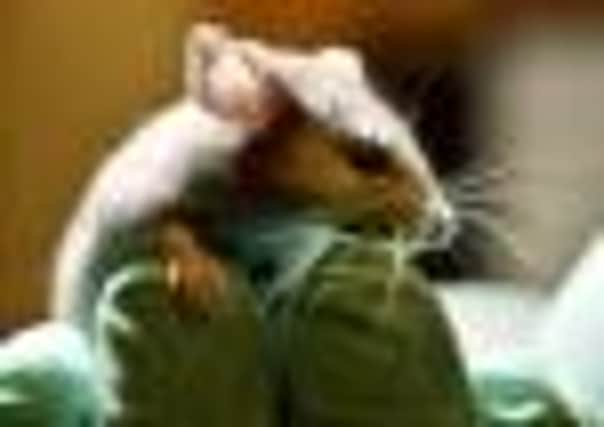Gillian Glover: Coming to the rescue soon – Mighty Mouse


I’M AFRAID Shakespeare got it wrong. Doubtless due to insufficient marketing experience. Had he laboured more extensively for the Stratford-on-Avon Chamber of Commerce – perhaps inserted some pop-up advertising during the slower passages of the history plays – no character of his devising could ever have demanded: “What’s in a name?” The answer, as everyone from Lady Macbeth to Lady Gaga knows, is “destiny”. Even for four-footed creatures.
I was reminded of this axiom by a recent article in the New York Times detailing the results of experiments in Brisbane, Australia, and at several universities in America, involving “personalised animal models”. Now, back when Dr Lister was first scrubbing up, medicine employed countless “animal models,” or guinea pigs as most people called them. However, they were not “personalised”.
Advertisement
Hide AdAdvertisement
Hide AdThe crucial step forward for medical research is that these 21st-century rodents are bred to be immune deficient and therefore can be transplanted with a patient’s specific ailments. The patient’s own immune system can then be replicated and tumours grafted. The result is a research superhero – or a “mouse avatar” as it has been named; a remarkable creature whose response to drug combinations and other interventions is a reliable predictor of what the human patient will experience, without that patient having to suffer the chemical toxicity of such testing.
These are no longer “timid, cooerin’ beasties” – they are miniaturised Captain Valiants, Mini Me-s struggling to gift a healthier future to humanity. Predictably, humanity’s gratitude is proving rather patchy: the patients involved so far have reported “no particular attachment” to their mice, but this tepid response is counterbalanced by the messianic glee with which the researchers observe and cherish the avatars’ every new development. It seems there are few areas of medicine in which the future cannot be mouse-shaped.
It was while reading the possible applications of heroic mouse avatars to the field of diet and nutrition that distant alarm bells began to sound. “The ‘humanised’ mice might be used to study, for instance, how a change in diet might affect a person’s health,” a University of Washington spokesman had remarked.
Aha! This was becoming a bit clearer. Not only will our future selves be forced to confront our diseases living separate lives outside our bodies ( “the four mice at the front have your pancreatic tumour, the brown one at the back who keeps bumping into things has your eye disorder…”) but our personal mice will also be forced to show us the error of our ways – as if the mirror wasn’t sufficient on that count.
I can imagine it all too clearly. A shiny-cheeked ten-year-old masquerading as a doctor will guide me towards my mouse colony. “Have a look at the piebald mouse over there,” he’ll say. “The one who’s not playing on its wheel. The one lying on its back, with its eyes half-closed, barely tapping one paw. That’s pretty much you at the moment. We’ve programmed the feeder tubes to replicate your Chardonnay and bacon sandwich diet, and I’m sorry to say things aren’t looking good.”
“But she’s smiling,” I’ll argue. “Well, it must be a private joke. Over here is the happy mouse. He wakes early every morning to get in an extra session of exercise, only eats spinach and whole grains, drinks plain water. He’s healthy as a mouse half his age. Just look at him run”.
“I’d run too, if I could,” I’ll say. And with any luck I’ll wake up at that point and discover that the future is still delayed due to budget constraints, and so this particular health humiliation is still distant for NHS patients. After all, the going rate for the preliminary mouse colony as paid to a New Jersey laboratory by the Feeney family was $25,000 (about £16,400). Not only is this a hefty expense to be shouldered by the NHS, but if the process were to become a standard prognostic tool for hospital admissions, it would require a Pied Piper number of mice.
So before we submit to the arcane glamour of the avatar, perhaps we should look closer to home for our health solutions. To Staffordshire, for instance, sad capital of a defunct porcelain industry where sci-fi extravagance last visited with Josiah Wedgwood’s nephew, a certain Charles Darwin. Here, one health authority has published a jaunty plan entitled Fit for the Future. Amid the usual waffle about improved outpatient services and healthier lifestyle lurks a truly astonishing paragraph. “Intermediate Care – more beds in the local community… so people can recover or receive treatment in a more appropriate place for their individual needs.”
Advertisement
Hide AdAdvertisement
Hide AdSurely this is more bizarre than even a troop of mouse avatars . What does it mean ? And where would such beds be located?
A nice twin in the back room of the Horse and Handbag ? (Well, Frank always liked his pint, so we thought it would be best to get the bed set up here…) Local B&B landladies taking on-line basic nursing courses from the Kneestitching College of Katmandu? I’ve never heard of “beds in the local community” unless they were neatly arranged inside a shop which sold the same.
Perhaps this is what Andrew Lansley really meant by introducing a more” competitive edge” to the NHS in England. In the proper capitalist model, he was trying to declare a free market. You, me, a few mice, and beds anonymous – all welcome to participate in a fresh Carry-On Nurse feature. But he didn’t hit on a really good name for his plan. No magical mouse avatars. No glorious glimpse of a better future. Just his own name, which suddenly seems to have lost a lot of cachet. And it wouldn’t take Shakespeare to explain that.